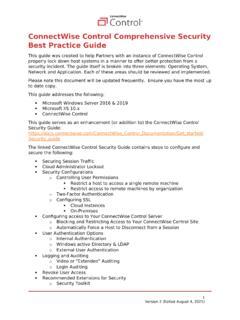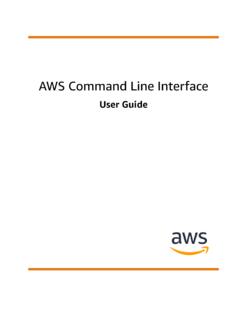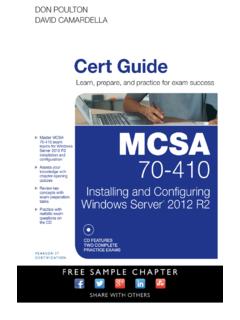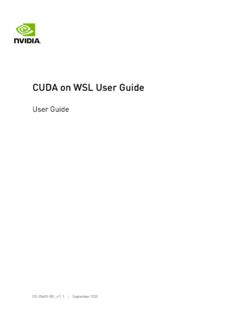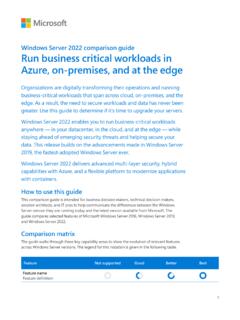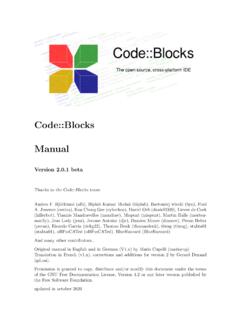Transcription of Automate Comprehensive Security Best Practice Guide
1 Edited: April 18, 2022 ConnectWise Automate Comprehensive Security Best Practice Guide Overview This Guide was created to help partners with an instance of ConnectWise Automate properly lock down host systems in a manner to offer better protection from a Security incident. The Guide itself is broken into three elements: Operating System Network Application Each area should be reviewed and implemented. Please note this document will be updated frequently. Ensure you have the most up-to-date copy. This Guide addresses the following: Microsoft windows Server 2016 & 2019 Microsoft IIS ConnectWise Automate v2020+ 2 Contents Operating System Hardware Guidelines (Before application install) .. 3 user Accounts and Permissions .. 3 STIG Items to Modify .. 3 Network Hardening Guidelines.
2 7 windows Defender Firewall on Automate Server .. 7 Disable TLS and in the registry .. 8 Application Hardening Guidelines .. 9 Additional Automate Hardening Items .. 9 Permissions .. 9 IIS Hardening Items .. 9 HTTP Headers .. 9 Disable HTTP Options .. 10 API Integrations .. 10 Permissions .. 11 Restrict Administrative Access by IP Address for the Automate Server .. 13 Prerequisites .. 13 Web Server Design .. 13 Plugin and Integration Communication .. 14 Prepare the Server .. 14 Determine the Required Configuration .. 14 Add Allow Rules .. 15 Add Deny Rules .. 15 Verify the Rules .. 16 3 Operating System Hardware Guidelines (Before application install) Review the Security Technical Implementation Guides (STIGs) as a methodology to secure Microsoft Server 2016 and 2019. Many of the High and Medium standards are addressed inside the AWS Standard Server AMI for the Cloud instances.
3 The user account and STIGs information below are strongly recommended for the ConnectWise Automate server. The IT Nation Secure team is recommending Partners implement the STIGs located here: Server 2016: Server 2019: IIS 10: user Accounts and Permissions It is highly recommended that user accounts with access to the Automate server and all servers, should have non-privileged (non-administrator) access for their initial login. Only users with a need for privileged access to the Automate server, or any other server, should be provided a SECOND individual account with ONLY the minimum level of access needed to accomplish their specific job role and function. Limiting user access ensures compliance to the STIG and limits the overall risk exposure for the system and services provided.
4 The assigned privileged account should NOT be used for initial login, and it is recommended that the enforcement of privileged accounts be restricted via GPO on the Automate server and across all servers. STIG Items to Modify Run 1. Network access. Do not allow anonymous enumeration of SAM accounts and shares. Configure the policy value for Computer Configuration > windows Settings > Security Settings > Security Options > Set Network access: Do not allow anonymous enumeration of SAM accounts and shares to Enabled. 4 2. Disallow AutoPlay for non-volume devices. Configure the policy value for Computer Configuration > Administrative Templates > windows Components > AutoPlay Policies > Set Disallow AutoPlay for non-volume devices to Enabled (Server 2016: Computer Configuration\ windows Settings\ Security Settings\Local Policies\ Security Options).
5 3. Set the default behavior for AutoRun. Configure the policy value for Computer Configuration > Administrative Templates > windows Components > AutoPlay Policies > Set the default behavior for AutoRun to Enabled and select the Do not execute any autorun commands option. 4. Turn off AutoPlay. Configure the policy value for Computer Configuration > Administrative Templates > windows Components > AutoPlay Policies > Set Turn off AutoPlay to Enabled and select the All Drives option. The above setting is discussed in some detail within the Certify Fundamentals course available under the ConnectWise University. Please ensure NO ONE is added to Act as part of the operating system in the GPO. 5. Verify the effective settings within the Local Group Policy Editor. 5 Navigate to Local Computer Policy > Computer Configuration > windows Settings > Security Settings > Local Policies > user Rights Assignment.
6 If any accounts or groups (to include administrators) are granted the Act as part of the operating system user right, the accounts should be removed immediately from this policy object. Another setting to pay attention to on all Microsoft windows Servers is the privilege escalation. 6. Always install with elevated privileges. Configure the policy value for Computer Configuration > Administrative Templates > windows Components > windows Installer > Set Always install with elevated privileges to Disabled. The Not Configured setting uses the user s current permission set. This is part of the reason having TWO accounts is very important. Please also note the Caution item in the following graphic. Additionally, Microsoft windows Server administrative accounts must not be used with applications that access the Internet, such as web browsers, or with potential Internet sources, such as email.
7 Using applications that access the Internet or have potential Internet sources using 6 administrative privileges exposes a system to compromise. If a flaw in an application is exploited while running as a privileged user , the entire system could be compromised. Web browsers and email are common attack vectors for introducing malicious code and must not be run with an administrative account. Since administrative accounts may generally change or work around technical restrictions for running a web browser or other applications, it is essential that policy require administrative accounts to not access the Internet or use applications such as email. The policy should define specific exceptions for local service administration. These exceptions may include HTTP(S)-based tools that are used for the administration of the local system, services, or attached devices.
8 Whitelisting can be used to enforce the policy to ensure compliance. 7 Network Hardening Guidelines windows Defender Firewall on Automate Server Verify that only the following ports are open: Port 75 UDP: Utilized by the Enhanced Heartbeat. Port 443 TCP: Used for HTTPS communication. Port 8484 TCP: Must be open and forwarded to the Automate server in order to access the Solution Center from the Control Center. Local machine access on any port from using any protocol should be opened (local machine access). Verify the following ports and protocols are closed: Port 70 TCP: Redirector communications without tunnels. Ports 70-74 UDP: Tunnels and Redirectors. Port 8002 TCP/UDP: For tunnels, the remote agent and the Control Center must be able to communicate to on port 8002 TCP/UDP.
9 Ports 40000-40050 TCP: Connecting via HTTP from the Web Control Center. Open ports beginning with 40000 and ending with four times the number of total technicians using Automate ( , If there are 25 technicians, then there are 25x4 (100) simultaneous sessions. So, ports 40000-40100 should be open). Ports 40000-41000 UDP: Tunnels and Redirectors, only when advanced routers are blocking and not at the Automate server, at client and agent locations or where the router in front of the Control Center is blocking. Port 3389: windows RDP. This must be disabled after a ConnectWise Control client is running or there is another way to access the system. Also ensure that the perimeter firewall is blocking port 3389 for all machines. Port 3306: MySQL. Block this port on the perimeter router.
10 If using a single system for Automate and database, 3306 should only be available locally. If using two separate systems, 3306 on the database machine should only be available on the private network and only accessible from the Automate machine. Port 12413 TCP: Used by the Automate File Service. This service is for internal communications between the Automate server and its applications and should not be accessible by other devices and networks. All partners should verify that port 12413 TCP is closed to external devices and networks. 8 If not connected to Active Directory, these ports can be blocked. Port 135: MSRPC. Remove firewall rule to allow TCP-135. Port 139: NetBios. Remove firewall rule to allow TCP-139. Port 445: Microsoft-ds. Remove a firewall rule to allow TCP-445.
